#Federico II Hohenstaufen
Explore tagged Tumblr posts
Text
Estatua ecuestre de San Fernando (Sevilla)
Hoy vamos a tratar un monumento especial: el realizado en honor del rey Fernando III el Santo, hoy en la llamada Plaza Nueva en el barrio del Arenal, distrito Casco Antiguo, con la disposición que se ve en la foto anterior. Continue reading Estatua ecuestre de San Fernando (Sevilla)

View On WordPress


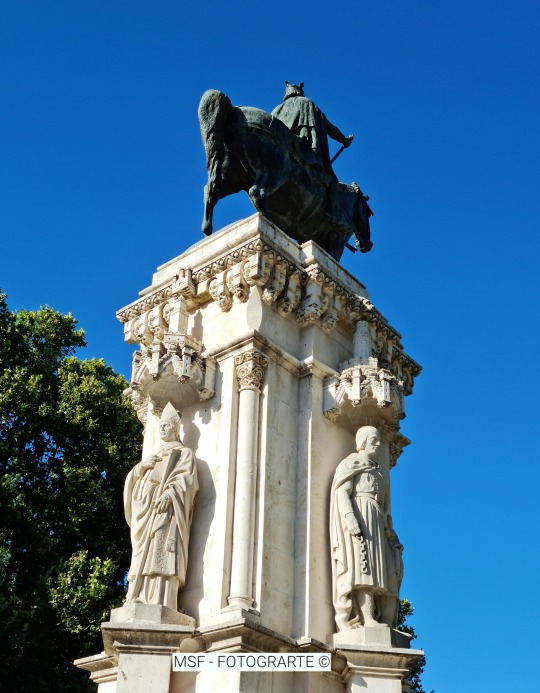

#Alfonso López Rodríguez#Alfonso X el Sabio#Beatriz de Suabia#Doña Inés Rodríguez de Girón#Don Remondo o Raimundo de Losana#Enrique Pérez Comendador#Escultura#Escultura civil#Federico II Hohenstaufen#Felipe de Castilla#Fernando III el Santo#Garci Pérez de Vargas#Joaquín Bilbao#Joaquín Sánchez Cid#Lafita Díaz#Ramón de Bonifaz#Sevilla
0 notes
Text



Crown of Costance
12th-13th century.
Cathedral of Palermo, Italy.
#photos by: meee#hohenstaufen#medieval history#medieval art#middle ages#Frederick II#Federico II#norman sicily#sicily#12th century#13th century#medieval
12 notes
·
View notes
Text
Volti dei tre anziani della Cattedrale di Termoli

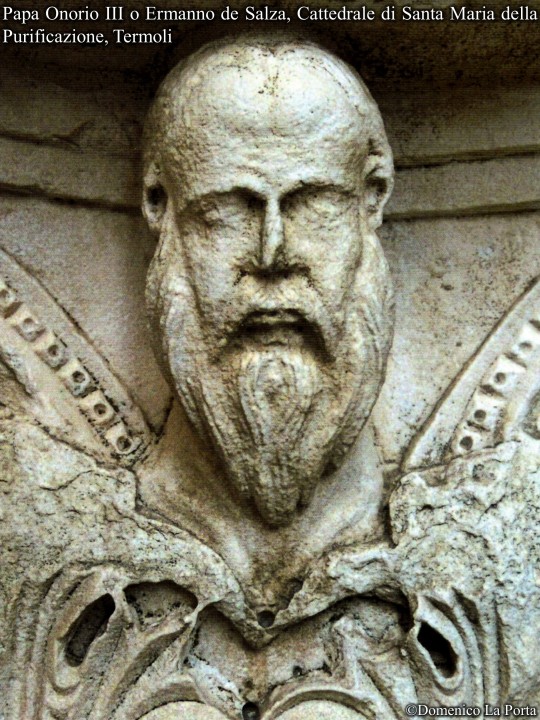
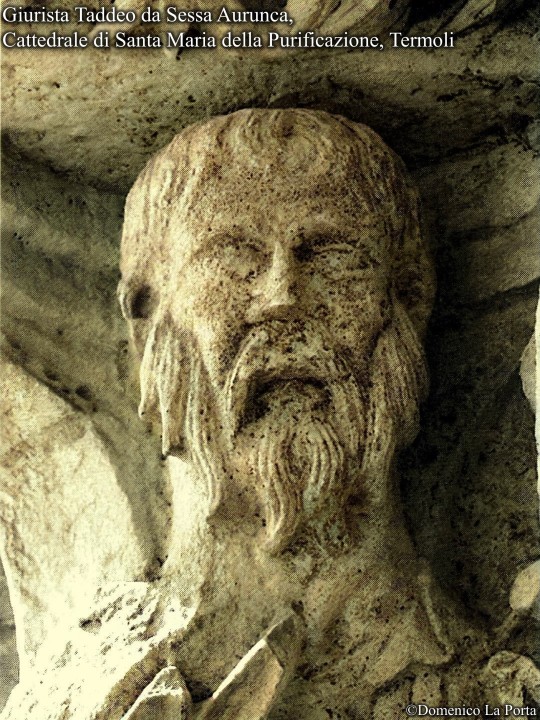
Nel lato sinistro del capitello, il consigliere e giurista di Federico II, Pier delle Vigne, mentre nel lato destro abbiamo il secondo giurista più vicino all'imperatore, Taddeo da Sessa, e nel centro, un anziano dalla lunga barba ed il volto malinconico o dolente, identificabile come il pontefice Onorio III, magister regis dell'infante Federico, oppure il terzo più importante consigliere di quest'ultimo, il gran maestro teutonico Ermanno de Salza.
Cattedrale di Santa Maria della Purificazione, Termoli (CB), prima metà del XIII secolo (1225-1235), secondo capitello del lato sinistro della facciata principale.
#storia#molise#italia#termoli#medioevo#archeologia#arte#cultura#federico ii#federico ii di svevia#italy#frederick ii#hohenstaufen#papa Onorio III#Onorio III#Ermanno de Salza#Hermann Von Salza#Pier delle Vigne#Taddeo da Sessa#art#medieval art#13th century#medieval europe#normanni#svevi#romanico#architettura#storia dell'arte#architecture#cattedrale
4 notes
·
View notes
Text

Napoli - Francesco Laurana - Maschio Angioino - Arco trionfale - 1479
Fondata dai Greci di Cuma, i sovrani che nei secoli si sono susseguiti sul trono di Napoli sono stati:
i Normanni:
- Ruggero I d’Altavilla conquistò la Sicilia nel 1091;
- Ruggero II (1130 - 1154): fu il primo re di una Sicilia multietnica e multireligiosa avendo accorpato in un unico regno tutti i possedimenti normanni nell’Italia Meridionale conquistando Napoli nel 1137;
- Guglielmo I (1154 - 1166)
- Guglielmo II (1166 - 1189): eresse il Duomo di Monreale;
- Tancredi (1189 - 1194)
- Guglielmo III (1194)
- Costanza d’Altavilla (1194 - 1197)
gli Svevi:
- Federico II (1198 - 1250) Stupor Mundi: a Napoli istituì l’università nel 1224;
- Corrado (1250 - 1254): dovette confrontarsi con il potere del fratellastro Manfredi;
- Corradino (1254 - 1258): fu sconfitto nella battaglia di Tagliacozzo e fatto imprigionare a Castel dell’Ovo e decapitare da Carlo d’Angiò nella piazza del mercato a Napoli, poi sepolto nella vicina Chiesa del Carmine. La dinastia degli Svevi scomparve con la morte di Manfredi nel 1266.
gli Angioini:
- Carlo I (1266 - 1285): fratello di Luigi IX il Re Santo, Conte d’Anjou, ricevette in vassallaggio la Sicilia e Napoli dal Papa che difese dagli Hohenstaufen. Edificò il Maschio Angioino, con uno stile che richiama il castello di Avignone, nel 1282;
- Carlo II (1285 - 1309): dovette rinunciare al trono di Sicilia dopo la rivolta dei Vespri Siciliani nel 1302;
- Roberto I (1309 - 1343): figlio di Maria d’Ungheria sepolta nella Chiesa di Donnaregina, fu apprezzato da Petrarca e amante della cultura e delle lettere;
- Giovanna I (1343 - 1382): fu fatta assassinare dal ramo di Durazzo degli angioini e le succedette
- Carlo (1382 - 1386)
- Ladislao (1386 - 1414)
- Giovanna II (1414 - 1435)
- Renato I (1435 - 1442)
gli Aragonesi:
- Alfonso I d’Aragona (1442 - 1458): sconfisse Renato d’Angiò e unì il tono di Napoli a quello di Sicilia e ai possedimenti della Sardegna e della Spagna occidentale. Combattè contro Milano e Genova e dotò il Maschio Angioino dell’attuale arco di trionfo;
- Ferdinando I detto Ferrante (1458 - 1494): all’inizio del suo regno dovette fronteggiare la rivolta angioina e successivamente sedò la rivolta dei baroni e si alleò con gli Sforza contro il re di Francia Carlo VIII d’Angiò. Del suo tempo la Chiesa del Gesù Nuovo;
- Alfonso II: sposò Ippolita Maria Sforza, ma dovette abdicare a causa della calata di Carlo VIII;
- Ferrandino (1494 - 1496)
- Federico I (1496 - 1503) durante il cui regno vi fu la conquista e poi la cacciata di Luigi XII re di Francia;
- Ferdinando III (1504 - 1516) dopo il quale il Regno di Napoli fu incluso in quello di Spagna prima sotto la casata degli Asburgo (con la breve parentesi della Repubblica di Masaniello fra il 1647 e il 1648) poi sotto quella dei Borbone (1700 - 1713) ed ancora sotto quella degli Asburgo d’Austria (1713 - 1734).
i Borboni:
- Carlo I (1734 - 1759): già Duca di Parma, conquistò e riunificò il Regno delle Due Sicilie anche grazie alla madre Elisabetta Farnese, seconda moglie del re di Spagna, che da Madrid influenzò la prima parte del suo regno. Riformò con Bernardo Tanucci l’amministrazione, promosse la musica (fondò il Teatro di San Carlo nella patria di Paisiello e Pergolesi), l’arte (promosse la ceramica di Capodimonte, fece costruire al Vanvitelli la reggia di Caserta del 1751 e quella che oggi è Piazza Dante oltre alla Reggia di Capodimonte dove installò la collezione Farnese) e sostenne gli scavi a Pompei ed Ercolano che iniziarono nel 1738);
- Ferdinando (1759 - 1799 e 1816 - 1825): sposò una figlia di Maria Teresa d’Austria, Maria Carolina che lo allontanò dall’influenza spagnola di Bernardo Tanucci, promosse la Marina Militare (nel 1787 fu fondata la Nunziatella), ma dovette subire una rivoluzione filo-francese (Eleonora Fonseca Pimentel, Mario Pagano, …) nel 1799 contrastata dal Cardinale Ruffo e da Fra Diavolo e la conquista napoleonica che insediò Giuseppe Bonaparte dal 1806 al 1808 e Gioacchino Murat dal 1808 al 1815 prima di diventare, con il Congresso di Vienna, Re delle Due Sicilie ed essere sepolto al Monastero di Santa Chiara;
- Francesco (1825 - 1830)
- Ferdinando II (1830 - 1859): fondò la prima ferrovia d’Italia (1839), ma fu reazionario e soprannominato il Re Bomba per come represse i moti rivoluzionari del 1848 a Messina;
- Francesco II (1859 - 1861): era figlio di Ferdinando II e di Maria Cristina di Savoia e sposò la sorella di Sissi, Maria Sofia di Baviera.
Con l’Unità, Napoli confluì nel Regno d’Italia: ecco perché la statua di Vittorio Emanuele II è presente a Palazzo Reale.
7 notes
·
View notes
Text
¡Viva la Alemania secreta!

Por Lionel Baland
Traducción de Juan Gabriel Caro Rivera
Cuando el conde Claus von Stauffenberg fue fusilado en Berlín el 21 de julio de 1944, tras haber colocado el día anterior una bomba en el cuartel general de Adolf Hitler en Rastenburg, en Prusia Oriental, gritó, en referencia a su mentor, el poeta simbolista renano Stefan George: «¡Viva la Alemania secreta!» (1). Este es un mito arraigado en el mundo imperial de los Hohenstaufen creado por Federico I Barbarroja y Federico II y que luego se introduciría en la poesía, de forma codificada, en los himnos de Friedrich Hölderlin (2) y en los escritos de Friedrich Schiller, Heinrich Heine, Paul de Lagarde y Julius Langbehn, así como en la leyenda de Federico I Barbarroja dormido en un castillo subterráneo en las profundidades de la cordillera de Kyffhäuser (3).
Karl Wolfskehl, miembro del círculo formado en torno al poeta Stefan George, utilizó el término «Alemania secreta» en un texto publicado en 1910 en el Jahrbuch für die geistige Bewegung (4) titulado «Die Blätter für die Kunst und die neueste Literatur» (Las hojas para el arte y la novísima literatura). Stefan George y los tres hermanos Stauffenberg – los gemelos Alexander y Berthold, junto con Claus – se conocieron en Marburgo en la primavera de 1923. Ernst Kantorowicz, otro miembro del círculo de Stefan George y futuro autor de Los dos cuerpos del rey viajó a Roma en la primavera de 1924 con sus amigos historiadores y los gemelos Stauffenberg, Alexander y Berthold. En mayo de 1924, durante la Semana Santa, algunos de ellos viajaron a Nápoles, Paestum y luego a Segesta y Palermo, en Sicilia. Entre ellos se encontraban varios miembros del Círculo Stefan George, como Ernst Kantorowicz y Berthold von Stauffenberg. Cuando las autoridades italianas celebraban el 700 aniversario de la fundación de la universidad por Federico II de Hohenstaufen, depositaron una corona sobre su sarcófago con las palabras «A su emperador y héroe, la Alemania secreta».
En el otoño de 1924 Claus von Stauffenberg escribió a Stefan George para decirle que la obra de George le había despertado y que estaba listo para la acción al servicio de la «Alemania secreta». «Geheimes Deutschland» (Alemania secreta) es el título de un poema de Stefan George escrito a principios de los años veinte y publicado (5) en la colección de poemas Das neue Reich (El nuevo reino o El nuevo imperio) en 1928. La Alemania secreta, a partir de la cual debía desarrollarse el «Nuevo Reich», era el círculo orgánicamente formado por personas reunidas en torno a Stefan George. La Alemania de Stefan George, que supuestamente representa a la Alemania real, es vital, fuerte y pura. Es una Alemania paralela a la de la sociedad de la época, la falsa Alemania del individualismo y la sociedad burguesa encarnada en la República de Weimar, y en última instancia debe sustituirla. La cuestión es cómo deshacerse de la segunda. Las ideas de Stefan George eran elitistas, jerárquicas, antidemocráticas y antirracionalistas.
El nuevo régimen
Después de que Adolf Hitler se convirtiera en canciller el 30 de enero de 1933 la división dentro del círculo de seguidores de Stefan George se acentuó. El conde Woldemar von Uxkull-Gyllenband (6), catedrático de Historia en Tubinga, era de los que veían en el Tercer Reich la realización del «Nuevo Reich» profetizado por el maestro y el 12 de julio de 1933, con motivo del 65 cumpleaños de éste, pronunció una conferencia en la que lo presentaba como el predecesor intelectual de la revolución nacionalsocialista.
Cuando Ernst Kantorowicz, al igual que Stefan George, recibió el texto de esta conferencia, se horrorizaron porque, en aquel momento, las medidas políticas adoptadas por los nuevos dirigentes de Alemania iban dirigidas contra los judíos, siendo Kantorowicz uno de ellos. En consecuencia, decidió oponerse públicamente al intento del nuevo régimen de recuperar las ideas de Stefan George (7). Ernst Kantorowicz pronunció un discurso (8), un verdadero acto de resistencia, el 14 de noviembre de 1933, con motivo de la prohibición de su cátedra universitaria en Fráncfort del Meno, titulado «La Alemania secreta», en el que afirmaba la incompatibilidad entre el Reich de Adolf Hitler y el Reich de Stefan George. Ernst Kantorowicz afirmaba que Karl Wolfskehl, en su texto publicado en el Jahrbuch für die geistige Bewegung de 1910, transformó el significado del término «Alemania secreta», que había sido acuñado por Paul de Lagarde y retomado por Julius Langbehn, quien le dio alas a lo que Rembrandt, Ludwig van Beethoven y Johann Wolfgang von Goethe denominan como «El verdadero emperador de la Alemania secreta». Según Kantorowicz, Wolfskehl se refiere con esta expresión a «individuos, portadores de ciertas fuerzas alemanas aún latentes en las que se prefigura o encarna el más sublime ser de esta futura nación». Ve en la «Alemania secreta» «los receptores de una fuerza inmutable, eternamente igual, que permanece secreta como una corriente subterránea bajo la Alemania visible y que sólo puede captarse a través de imágenes». Esta «Alemania secreta», despertada por la nueva poesía, sólo existe en el entorno de Stefan George y nunca debe identificarse con un régimen político existente, porque es una cuestión de espiritualidad, de elección, de alma y espíritu, no de nacimiento ni de sangre, tampoco un tiene carácter nacional o racial: «La Alemania secreta está siempre cerca, incluso presente, como un juicio final y una revuelta de los muertos. [...] Un reino que es a la vez de este mundo y no de este mundo, un reinado que está aquí y no está aquí, un reino tanto de los vivos como de los muertos, que se transforma y, sin embargo, es eterno e inmortal». Lo define como «una comunidad secreta de poetas y sabios, héroes y santos, sacrificadores y sacrificados, que Alemania ha engendrado y que se han ofrecido a Alemania» (9).
En la primavera de 1933, Stefan George rechaza la petición de Joseph Goebbels, Ministro de Propaganda del Tercer Reich, de presidir una nueva Academia Alemana de Poesía depurada de escritores considerados indeseables por el nuevo régimen, aunque se congratula de que sea «bajo un signo nacional», no niega en absoluto ser el antecesor del nuevo movimiento nacional y no deja de lado su colaboración espiritual y señala que las leyes de las esferas espiritual y política son muy diferentes y que su encuentro constituye un proceso extremadamente complicado (10).
Stefan George se trasladó a Tesino (Suiza), donde pasaba el invierno desde hacía varios años. Los hermanos Stauffenberg le acompañaron durante el viaje. Reaccionaron de forma diferente ante el advenimiento del Tercer Reich: Berthold y Alexander se mostraron reservados, mientras que Claus, al parecer, había participado en manifestaciones públicas a favor de Adolf Hitler y lo aprobaba.
Su discípulo Karl Wolfskehl, judío, le imploraba mediante cartas que se posicionara frente al nacionalsocialismo y apoyara a los judíos, o al menos a los miembros de su círculo, Stefan George guardaba silencio. Klaus Mann escribió: «Esperamos que su silencio signifique rechazo» y «Hitler y Stefan George son dos mundos que nunca pueden fluir el uno hacia el otro (11). Para Stefan George las medidas tomadas contra los judíos por el Tercer Reich eran probablemente secundarias con respecto al destino futuro de Alemania, a la que veía enfrentarse a graves dificultades en las décadas venideras.
La muerte del maestro
Mientras Stefan George agonizaba, los tres hermanos Stauffenberg pudieron visitarlo. Sin embargo, Ernst Kantorowicz fue disuadido de hacerlo por el entorno del poeta, que incluía a Robert Boehringer, albacea de Stefan George, para evitar ofender a las autoridades nacionalsocialistas alemanas con la presencia de un judío y perturbar así la recepción de su obra en Alemania (12). Stefan George murió en el hospital de Locarno el 4 de diciembre de 1933, habiéndose cuidado de no hacer ninguna declaración decisiva sobre el nuevo régimen, del que sólo había visto los primeros signos (13).
En el funeral de Stefan George, que se celebró en medio de un círculo reducido, existía un abismo gigantesco entre los partidarios y los detractores del nacionalsocialismo. El envío por parte del gobierno alemán de una corona de laurel con una cinta en la que figuraba una esvástica provocó una discusión entre los que querían ocultar o eliminar la esvástica y los que querían mostrarla. Entre los participantes estaban Hanna y Karl Wolfskehl, los tres hermanos Stauffenberg y Ernst Kantorowicz.
Poco antes de su muerte, Stefan George nombró como su único heredero a Robert Boehringer. Como Boehringer vivía en Suiza, esto complicó las cosas en Alemania y Claus von Stauffenberg se convirtió en el heredero sustituto de Stefan George.
En el verano de 1934, Claus von Stauffenberg, al igual que sus compañeros de regimiento, juran fidelidad al Führer del Imperio y al pueblo alemán y le reconocen como jefe del ejército. A finales de la década de 1930 Claus von Stauffenberg negoció con el ayuntamiento de Bingen am Rhein que la casa familiar de Stefan George fuera convertida en monumento. Cada año, los hermanos Stauffenberg y Robert Boehringer se reunían en Minusio en el aniversario de la muerte del maestro.
Las consecuencias del atentado
Claus von Stauffenberg colocó una bomba en el cuartel general de Adolf Hitler en Rastenburg, Prusia Oriental, el 20 de julio de 1944 y fue fusilado en Berlín al día siguiente. Según testigos, gritó «¡Es lebe das geheime Deutschland!» o «¡Es lebe unser heiliges Deutschland!» (¡Viva nuestra santa Alemania!). Los terribles disparos sonaron cuando pronuncia el final de esta frase. En su libro (14) sobre Stefan George, el historiador suizo Edgar Salin relata lo que su antigua alumna, la condesa Marion Dönhoff, le contó: el movimiento de resistencia de 1943-1944, al que ella había estado vinculada, se había formado bajo la influencia del conde Claus von Stauffenberg bajo el nombre de «Alemania secreta» (Geheimes Deutschland o Heimliches Deutschland).
El 10 de agosto, Berthold von Stauffenberg, hermano y confidente de Claus, fue condenado a muerte por haber participado en el complot, relacionado con el atentado, para derrocar el régimen nacionalsocialista. Fue ejecutado en la horca ese mismo día. El tercer hermano Stauffenberg, Alexander, gemelo de Berthold, fue encarcelado por estar emparentado con los otros dos, al igual que toda la familia Stauffenberg, incluidos hijos y parientes cercanos. La sede de la familia Stauffenberg en Lautlingen, Suabia, fue registrada de arriba abajo por la Gestapo, que encontró numerosos documentos relacionados con el poeta Stefan George, incluido el testamento en el que se nombraba heredero principal a Robert Boehringer en Ginebra y heredero secundario a Berthold.
La esposa de Alexander, Melitta Schiller, que procedía de una familia ruso-judía de Odessa y era piloto de pruebas industriales, dejó de usar el apellido Stauffenberg y se vió obligada a usar el apellido de Schenk. Durante un vuelo fue alcanzada por cazas británicos y consiguió realizar un aterrizaje de emergencia. Murió pocas horas después a causa de sus heridas el 8 de abril de 1945. Al final de la guerra, Alexander no tenía donde vivir, ya que su piso de Würzburg había sido destruido por las bombas y había perdido su trabajo como profesor universitario en Estrasburgo. En 1948 Delfin publicó un folleto de 15 páginas con poemas escritos por Alexander Stauffenberg en 1943 para conmemorar el décimo aniversario de la muerte de Stefan George.
Notas:
1. El grito „Es lebe das Geheime Deutschland!“ (¡Viva la Alemania secreta!) y también „Es lebe das heilige Deutschland!“ (¡Viva la Santa Alemania!).
2 – Jürgen W., Gansel, «Stefan George. Governor of the Secret Germany», en Conservative revolution. Responses to liberalism and modernity. Volume Five, Edited by Troy Southgate / Black front press, s.l., 2022, p. 107 à 112, ici p. 110.
3 – Olena Semenyaka, «Friedrich Nietzsche as the ‘’founder’’ of Conservative revolution», en Conservative revolution. Responses to liberalism and modernity. Volume Five, Edited by Troy Southgate / Black front press, s.l., 2022, p. 7 à 33, ici p. 24.
4 – p. 1 à 18
5 – p. 59 à 65
6 – Woldemar von Uxkull-Gyllenband se distancie ensuite rapidement du nouveau régime.
7 – Achim Aurnhammer, Wolfgang Braungart, Stefan Breuer und Ute Oelmann (Hrsg.), Stefan George und sein Kreis. Ein Handbuch, 2. Auflage, in Zusammenarbeit mit Kai Kauffmann. Redaktion: Birgit Wägenbaur, De Gruyter, Berlin/Boston, 2016, p.84-85.
8 – Ernst Kantorowicz, „Das Geheime Deutschland. Vorlesung, gehalten bei Wiederaufnahme der Lehrtätigkeit am 14. November 1933. Edition von Eckhart Grünewald“, in: Robert L. Benson, Johannes Fried (Hgg.), Ernst Kantorowicz. Erträge der Doppeltagung, Institute for Advanced Study (Princeton) / Johann Wolfgang Goethe-Universität (Frankfurt), Franz Steiner Verlag, Stuttgart, 1997, p. 77 à 93.
9 – Ibid., ici p. 80.
10 – Robert E Norton, Secret Germany. Stefan George and his circle, Cornell University Press, Ithaca & London, 2002, p. 728-729.
11 – Klaus Mann en Die Sammlung. Literarische Monatsschrift unter dem Patronat von André Gide, Aldous Huxley, Heinrich Mann, hrsg. von Klaus Mann, Reprint en 2 vol., Rogner und Bernhard bei Zweitausendeins, München, 1986, S. 98ff.
12 – Benjamin Demeslay, Stefan George et son cercle. De la poésie à la Révolution conservatrice, collection Longue Mémoire de l’Institut Iliade, La nouvelle librairie, Paris, 2022, p. 3-4.
13 – Introducción a Stefan George, Poésies complètes. Traduction et édition de Ludwig Lehnen. Nouvelle version, HD Éditions, Villiers St-Josse, 2023, p. 12.
14 – Edgar Salin, Um Stefan George. Erinnerungen und Zeugnisse, Helmut Küpper vormals Georg Bondi, München / Düsseldorf, 1954.
Bibliografía:
Aurnhammer Achim, Braungart Wolfgang, Breuerb Stefan, Oelmann Ute (Hrsg.), in Zusammenarbeit mit Kai Kauffmann. Redaktion: Birgit Wägenbaur, Stefan George und sein Kreis. Ein Handbuch, 2. Auflage, De Gruyter, Berlin/Boston, 2016.
Aurnhammer Achim, Stefan George in der deutschsprachigen Literatur des 20. Jahrhunderts. Aneignung – Umdeutung – Ablehnung, De Gruyter, Berlin/Boston, 2022.
Demeslay Benjamin, Stefan George et son cercle. De la poésie à la Révolution conservatrice, collection Longue Mémoire de l’Institut Iliade, La nouvelle librairie, Paris, 2022.
Egyptien Jürgen, Stefan George. Dichter und Prophet. Biographie, Theiss, Darmstadt, 2018.
Gansel Jürgen W., « Stefan George. Governor of the Secret Germany. », in : Conservative revolution. Responses to liberalism and modernity. Volume Five, Edited by Troy Southgate / Black front press, s.l., 2022, p. 107 à 112.
George Stefan, Poésies complètes. Traduction et édition de Ludwig Lehnen. Nouvelle version, HD Éditions, Villiers St-Josse, 2023.
Kantorowicz Ernst, „Das Geheime Deutschland. Vorlesung, gehalten bei Wiederaufnahme der Lehrtätigkeit am 14. November 1933. Edition von Eckhart Grünewald“, in: Robert L. Benson, Johannes Fried (Hgg.), Ernst Kantorowicz. Erträge der Doppeltagung, Institute for Advanced Study (Princeton) / Johann Wolfgang Goethe-Universität (Frankfurt), Franz Steiner Verlag, Stuttgart, 1997, p. 77 à 93.
Mann Klaus (Hrsg.), Die Sammlung. Literarische Monatsschrift unter dem Patronat von André Gide, Aldous Huxley, Heinrich Mann, reprint en 2 vol., Rogner und Bernhard bei Zweitausendeins, München, 1986.
Norton Robert E, Secret Germany. Stefan George and his circle, Cornell University Press, Ithaca & London, 2002.
Raulff Ulrich, „Apollo unter den Deutschen. Ernst Kantorowicz und das ,Geheime Deutschland‘“, in: „Verkannte brüder“? Stefan George und das deutsch-jüdische Bürgertum zwischen Jahrhundertwende und Emigration, (Hrsg.) Gert Mattenklott / Michael Philipp / Julius H. Schoeps. Haskala. Wissenschaftliche Abhandlungen. Herausgeben vom Moses Mendelssohn-Zentrum für europäisch-jüdische Studien. Band 22, Georg Olms Verlag, Hildesheim-Zurich-New York, 2001, p. 179 à 197.
Riedel Manfred, Geheimes Deutschland. Stefan George und die Brüder Stauffenberg, Kulurverlag Kadmos, Berlin, 2014.
Salin Edgar, Um Stefan George. Erinnerungen und Zeugnisse, Helmut Küpper vormals Georg Bondi, München / Düsseldorf, 1954.
Semenyaka Olena, « Friedrich Nietzsche as the ‘’founder’’ of Conservative revolution. », in : Conservative revolution. Responses to liberalism and modernity. Volume Five, Edited by Troy Southgate / Black front press, s.l., 2022, p. 7 à 33.
Travers Guillaume, Ernst Kantorowicz, col. Qui suis-je ?, Pardès, 2023.
Voswinckel Ulrike, Freie Liebe und Anarchie: Schwabing – Monte Verità. Entwürfe gegen das etablierte Leben, Allitera Verlag, Munich, 2009.
Fuente: https://www.revue-elements.com/vive-lallemagne-secrete/
1 note
·
View note
Text




IMAGENES Y DATOS INTERESANTES DEL DIA 27 DE JULIO DE 2024
Día Mundial del Cáncer de Cabeza y Cuello, Día Mundial de Andar con Zancos, Año Internacional de los Camélidos.
Santa Natalia, Santa Liliosa y San Constantino.
Tal día como hoy en el año 2012
Con la participación récord de 204 países, igualando a las anteriores celebradas en Beijing (China), se inauguran en Londres (Reino Unido) las XXVII Olimpiadas de la Era Moderna. Se clausurarán el 12 de agosto. Por primera vez todas las delegaciones cuentan con atletas femeninas. También Londres se convierte en la primera ciudad en ser sede de las Olimpiadas en tres ocasiones: en 1908, en 1948 y en el día de hoy. (Hace 12 años)
1953
Se firma en Panmunjeom el armisticio que pone fin a la Guerra de Corea entre Estados Unidos, Corea del Norte y China. Corea del Sur sólo queda como miembro observante al negarse a firmar el armisticio, quedando el paralelo 38 como línea de separación entre las dos Coreas, idéntica situación territorial que existía antes de la guerra. Este conflicto finaliza después de más de tres años de combates (iniciado el 25 de junio de 1950) y de aproximadamente cuatro millones de bajas (entre muertos y heridos). El daño económico y social de la guerra de Corea es espeluznante. No es, ni mucho menos, la una solución definitiva, sino tan solo a un arreglo transitorio. Durante décadas, el paralelo 38 continuará siendo un lugar de tensión. (Hace 71 años)
1866
Se inaugura el primer cable telegráfico trasatlántico de 3.700 km de longitud que une Europa con América, más concretamente Irlanda con Terranova. Cyrus Field, ciudadano americano, ha financiado la operación con su fortuna particular. (Hace 158 años)
1830
En Francia tiene lugar una revolución burguesa cuando el pueblo sale a la calle para protestar contra las medidas adoptadas por el rey Carlos X, que ha prohibido el Parlamento y pretende suprimir la libertad de prensa. Estas revueltas lograrán la subida al trono de Luis Felipe de Orleans, el "rey burgués". Carlos X y su familia, embarcarán rumbo a Inglaterra el 16 de agosto con un salvoconducto del propio Luis Felipe. (Hace 194 años)
1663
En Inglaterra, el parlamento aprueba la segunda Acta de Navegación, mediante la cual todas las mercancías europeas con destino a las colonias británicas en América deben llegar a su destino en buques con bandera inglesa. (Hace 361 años)
1214
En las cercanías del pueblo de Bouvines, en Flandes (actual Francia) tiene lugar la Batalla de Bouvines, decisivo choque militar entre el ejército francés y los ejércitos de una coalición de potencias europeas, lideradas por el excomulgado emperador del Sacro Imperio Romano Germánico Otón IV, por su tío el rey inglés Juan Sin Tierra, por Fernando, conde de Flandes, y por otros príncipes de menor entidad que han decidido poner freno al creciente poderío de Francia. El rey Felipe II de Francia, comandante del ejército francés, recibe el apoyo de Federico de Hohenstaufen, rival de Otón IV y pretendiente al trono imperial, al que apoya el Papa. Las tropas francesas, a pesar de ganar la batalla, tendrán que soportar, al igual que las tropas de coalición, miles de bajas. Tras la batalla, al año siguiente, Federico de Hohenstaufen será coronado emperador del Sacro Imperio Romano Germánico con el nombre de Federico II, y Francia seguirá extendiendo su dominio hasta convertirse en una de las primeras potencias de Europa. Para Juan Sin Tierra de Inglaterra la derrota también tendrá consecuencias: se verá obligado a firmar la Carta Magna el 15 de junio de 1215, al ser incapaz de resistir por más tiempo la rebeldía de sus nobles, debido a lo elevado de los impuestos que tienen que pagar y a la forma despótica en que ha venido ejerciendo los privilegios de su cargo a lo largo de los últimos años. (Hace 810 años)
587aC
Jerusalén, capital del reino de Judá, y su templo son destruidos por los ejércitos babilonios bajo su dinastía caldea, con el consiguiente cautiverio que durará hasta el 538 a. C. (Hace 2611 años)
1 note
·
View note
Text
Federico II riaccende rivalità tra Jesi e Ancona
Federico II Hohenstaufen, lo Stupor Mundi, sovrano, intellettuale, politico e condottiero che lasciò un’impronta indelebile nella storia medioevale, riaccende la rivalità tra Jesi e Ancona, nelle Marche. L’antico “derby”, scomparso persino dai campi di calcio, è tornato in auge all’annuncio che Ancona organizzerà un festival intitolato al grande svevo, senza coinvolgere la città di Jesi, dove il…
View On WordPress
0 notes
Photo

Capolavoro dell'architettura medievale, Castel del Monte fu fatto costruire da Federico II di Hohenstaufen di Svevia nel 1240. Le nostre miniature a ruba sui portali HANDMADE! 🏰💯 • • For order: 📲 whatsapp +39 3206139569 📩 [email protected] ✈️ worldwide shipping 🛒 10% sconto newsletter • • #portiamolapuglianelmondo #lafavolaincantata #WeAreinPuglia #fattoamano #bombonierefood #handmade #pugliafactory #madeinitaly #tuttofattoamano #artigianato #bonsaiulivo #creazioniartigianali #artigianatoitaliano #fattoamanoconamore #fattoconilcuore #foodbomboniere #visitpuglia #instacreazioni #instacreazioniartigianali #viamagazine #italianstories #segnapostioriginali #creazionihandmade #wellmade #segnapostipersonalizzati #blogger #creazionipersonalizzate #artigianisocialcommunity #segnaposto #maestroartigiano — view on Instagram https://ift.tt/PFC2zBq
0 notes
Text
Federico II di Svevia: la prospettiva metastorica d’Europa
Federico II di Svevia: la prospettiva metastorica d’Europa
di Andrea Virga La ricorrenza del 26 dicembre – 826° anniversario della nascita di Federico II di Hohenstaufen, Imperatore del Sacro Romano Impero e Re di Sicilia – costituisce un’occasione per riflettere su alcuni degli aspetti più propriamente metastorici, oltre che metapolitici, del nostro discorso, a partire peraltro dal simbolo che abbiamo scelto per rappresentare il GRECE Italia. Infatti…

View On WordPress
0 notes
Text
I need a fic with young Frederick II the Great (king of Prussia) being possessed by his great-great-great… -grandfather Frederick II Hohenstaufen (Holy Roman Emperor), since Frederick II (the Prussian one) is a descendant of Frederick II (the Medieval one) through Constance of Sicily, daughter of Manfred, who is a son of Frederick II Hohenstaufen.
Just imagine: 28-year-old Frederick, the new king of Prussia, doing his best to make Prussia a European superpower, patronising the arts, all in all being a king we don’t deserve.
And Frederick II who is bored with being silently dead, so he decides to be loudly dead and starts possessing his descendant every day, giving him advice on ruling the country, discussing why Voltaire is a great philosopher and just annoying young Frederick because why not.
#middle ages#duke’s jokes#federico ii#frederick ii#hohenstaufen#hohenzollern#kingdom of prussia#frederick the great#fanfic
56 notes
·
View notes
Text
Federico II di Svevia, Castello di Monte San Giovanni Campano.
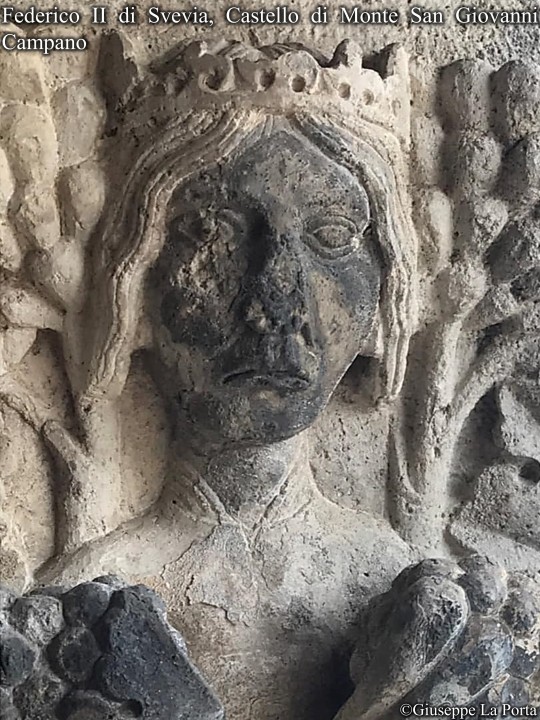
Opera della prima metà del XIII secolo.
#italia#medioevo#storia#archeologia#arte#cultura#federico ii#federico ii di svevia#Monte San Giovanni Campano#frederick ii#hohenstaufen#svevia#italy#history#storia dell'arte#art#medieval art#13th century#architettura#architecture
3 notes
·
View notes
Text


federico sesso
1 note
·
View note
Photo



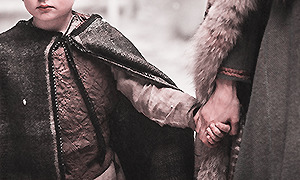


May 17th 1198. A 4 years-old Federico II Hohenstaufen is crowned King of Sicily
Soon after the death of the Emperor Henry, Constance had the child fetched from Foligno by an Apulian count and brought to Sicily. Dressed in widow’s weeds she awaited her son in Palermo. There were grave accusatory rumours against the Empress current at the time: some said she had poisoned her husband, and it was a matter of common knowledge that she had no love for Germans. The suspicion of murder was unjust, but the hatred for Germans ascribed to her was genuine enough; she shared it with her Sicilian fellow-countrymen and with the Italians oppressed by the Roman Curia. The foundations of this hate were the same then as they have always been: the arrogance "allied with unwisdom" of the Germans alienated the Mediterranean peoples, as did their "obstinacy and self-assertiveness."
Their physical strength and their savagery moreover terrified the Southerners, the discords prevailing amongst themselves brought them scorn and contempt. For rulers of the world they appeared "crude, coarse and uncivilised,” while their yet unpolished language seemed to the Romans "like the barking of dogs and the croaking of frogs." But the main factor in this hate was fear; fear of the inrush "of the winter and the storm into the rose-gardens of Sicily." This fear was not allayed by the savagely cruel treatment meted out to the Sicilians by Henry VI. Perhaps Innocent with his biblical phraseology hit on the right description of the German visitation of those days when he wrote: "Because the people of Sicily and the other inhabitants of this kingdom have grown effeminate in sloth, and undisciplined through too much peace, and, boasting themselves of their wealth, have given themselves over to the unbridled lusts of the body, their stink has gone up to heaven and the multitude of their sins has delivered them into the hands of the oppressor."
Innocent spoke thus out of no friendliness to the Germans. The hate of Germans that flamed up throughout Italy on the death of the Emperor had been carefully nurtured beforehand by the Curia, had been given the air of a national pan-Italian movement and utilised as a means to shake off the imperial yoke in the south in favour of a papal Italy. In resonant periods Innocent III had taken pains to stir up and foster this hate: "The wrath of the North wind whistles through the mountains with a new quaking of the earth, it drives through the level plains of Apulia, whirling dust into the eyes of wanderers and country-dwellers." Thus he wrote about the German,Henry VI, whom Dante also designated "that loud blast which blew the second over Swabia’s realm." A reaction of this sort against the tyranny of Henry VI was of course inevitable. The importance of the movement in Sicily was enhanced by the fact that the Empress Constance took part in it. Her motives were probably personal, for Henry had made a terrific clearance amongst all related to the old Norman royal house and had banished the survivors to Germany. On his death Constance immediately resumed the sovereignty of her hereditary domain, in accordance both with the Emperor’s instructions and with the right she herself possessed as Norman Queen. But the new ruler of Sicily was Norman Queen only: not widowed Empress; and the first act of her reign was to banish from her kingdom the Emperor’s interpreter, Markward of Anweiler, and with him all other German notables, a considerable number of whom held fief and office in the Norman territory. The pretext was that they might prove dangerous to the peace and quiet of the kingdom,especially Markward, who had not been slow to propose himself as vicegerent. Her next step was to imprison the Sicilian Chancellor, Walter of Palear, Bishop of Troia, who had been from of old an opponent of the Norman dynasty and a willing tool of the German Emperor. The intervention of the Pope was necessary to effect the liberation of the Bishop Chancellor and his re-instatement in his former offices. AntiGerman feeling in the south was so acute that the first German crusaders who were returning, all unsuspecting, from the Holy Land were surprised and plundered by the excited Sicilians, and after that the home-coming pilgrims had to avoid the har bours of this dangerously inhospitable kingdom. Curiously, the German princes who were on the Crusade, when they received in Acre the news of their Emperor’s death, reconfirmed the choice of Frederick as King of the Romans.
Constance, however, deliberately shut her eyes to all this. Her hate of Germany reinforced the maternal anxiety which heroes’ mothers are wont to suffer from: in the German crown she saw a never-ending series of future perils and struggles for her son. She would as far as possible ward off such a danger from him. Frederick should be king of the wealthy Sicily, and in the southern Land of Dreams he would quietly forget the imperial dignity of his fathers. A few months after the boy’s arrival in Palermo she had him crowned King of Sicily. The solemn rite was celebrated on Whit Sunday 1198, with a pomp and ceremony borrowed from the Byzantine court, while in accordance with ancient custom the people greeted their newly crowned king with the cry which may still be read on every crucifix in southern Italy "Christus vincit, Christus regnat, Christus imperat." It is significant to note that this is also the motto engraved on Frederick’s early seals. From that day Constance omitted from all official documents of the young king the title that had previously figured there: Rex Romanorum. From henceforth Frederick of Hohenstaufen was to content himself with the many titles borne by the reges felices of Norman stock. He was to be, body and soul, the son of the Sicilian Constance only, and to be kept aloof from all the fatal, unknown consequences in which the dangerous Hohenstaufen blood of his father might involve him. One is reminded of the childhood of Achilles or of Parzival.
Kantorowicz Ernst, Frederick II. 1198-1250, p. 13-16
#women#history#historicwomendaily#women in history#historical women#costanza i#Federico II#House of Hauteville#House of Hohenstaufen#norman swabian sicily#people of sicily#women of sicily#Palermo#province of palermo#yeah i know i was supposed to post it yesterday orz#you go constance coco
41 notes
·
View notes
Text
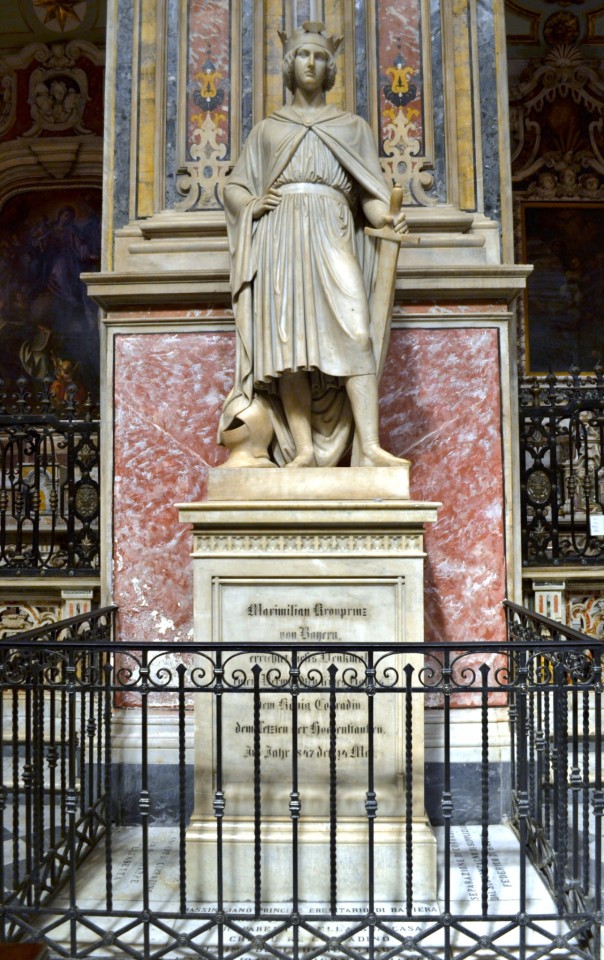
Bertel Thorvaldsen, Sepolcro di Corradino di Svevia (1847), Basilica di Santa Maria del Carmine Maggiore, Napoli.
#bertel thorvaldsen#neoclassicismo#napoli#naples#naples italy#campania#sud italia#arte#art history#art#scultura#scultpure#Corradino di Svevia#Hohenstaufen#Federico II
85 notes
·
View notes
Text
Here’s a few gems about Frederick II Hohenstaufen (aka Federico II) from Dan Jones’s book Crusaders:
Frederick was a truly extraordinary individual. He was not physically imposing: the Damascene preacher and historian Sibt Ibn al-Jawzi described him as red-faced, bald and shortsighted. “Had he been a slave, he would not have been worth two hundred dirhams,” Ibn al-Jawzi muttered. But what he lacked in hair and distance vision, Frederick amply made up for in the strength of his personality, breadth of his knowledge and extent of his imperial ambition.
Frederick gets excommunicated for postponing his crusade for the fourth time, but goes to Jerusalem anyway:
By the beginning of September Frederick was in Acre, preparing to throw himself into reorganizing the defenses of the kingdom. Yet his presence, although long anticipated, was now not universally welcomed. An excommunicate crusader was a contradiction in terms, and throughout Frederick’s time in the East he faced simmering hostility from the Templars—who refused to deploy troops any closer than a mile from his army—and the patriarch of Jerusalem, Gerold of Lausanne, who regarded Frederick as the devil incarnate.
Relationships between Frederick and sultan al-Kamil:
Frederick sent al-Kamil a set of his own armor as a token of his peaceful intentions, and the sultan graciously allowed Frederick to submit a list of difficult mathematical problems for the consideration of the finest scholars at the Ayyubid court. To the everlasting scandal and outrage of Patriarch Gerold, al-Kamil also sent to the emperor’s camp “dancing girls who sang and juggled.” Gerold complained that “the emperor lived and dressed totally like a Saracen, feasting and drinking with these dancers. . . . The emperor’s generosity to the Saracens was extreme, as though he was trying to buy the peace he was not able to obtain by force or fear.”
Frederick manages to peacefully regain Jerusalem for the crusaders:
On March 18 a triumphant (if still excommunicate) Frederick Hohenstaufen made his way into the Church of the Holy Sepulchre—the first Christian king to set foot there since Guy of Lusignan before the battle of Hattin in 1187. The crown of Jerusalem was waiting for him on the high altar. As he described the event to Henry III of England: “We, as being a catholic emperor... wore the crown, which Almighty God provided for us from the throne of his Majesty.” He did not add that he had in fact snatched it from the altar himself and placed it on his own head, forgoing any ritual of anointing or consecration.
Concluding remarks:
In total he was excommunicated four times between 1227 and his own death in 1250
Legends only
8 notes
·
View notes
